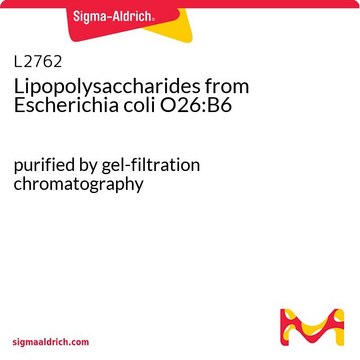L6893
Lipopolysaccharides (rough strains) from Escherichia coli F583 (Rd mutant)
Sinónimos:
LPS
Iniciar sesiónpara Ver la Fijación de precios por contrato y de la organización
Seleccione un Tamaño
Seleccione un Tamaño
Cambiar Vistas
About This Item
Número de CAS:
Número CE:
Número MDL:
Código UNSPSC:
12352201
NACRES:
NA.25
Productos recomendados
origen biológico
Escherichia coli (F583 Rd mutant)
Nivel de calidad
Formulario
lyophilized powder
impurezas
<3% Protein (Lowry)
color
white to yellow cast
solubilidad
water: 4.90-5.10 mg/mL, cloudy to turbid, colorless to faintly yellow
Condiciones de envío
ambient
temp. de almacenamiento
2-8°C
Descripción general
This product is phenol:chloroform:petroleum ether extracted from E. coli F 583 (Rd mutant). The source strain is from a private collection.
Aplicación
Lipopolysaccharides (LPSs) are characteristic components of the cell wall of Gram-negative bacteria. LPS and its lipid A moiety stimulate cells of the innate immune system by the Toll-like receptor 4 (TLR4), a member of the Toll-like receptor protein family, which recognizes common pathogen-associated molecular-patterns (PAMPs).
Acciones bioquímicas o fisiológicas
Lipopolysaccharides (LPS) are localized in the outer layer of the membrane and are, in noncapsulated strains, exposed on the cell surface. They contribute to the integrity of the outer membrane, and protect the cell against the action of bile salts and lipophilic antibiotics.
Nota de preparación
Prepared by phenol-chloroform-petroleum ether extraction.
The product is soluble in water (5 mg/ml) or cell culture medium (1 mg/ml) yielding a hazy, faint yellow solution. A more concentrated, though still hazy, solution (20 mg/ml) has been achieved in aqueous saline after vortexing and warming to 70-80 oC. Lipopolysaccharides are molecules that form micelles in every solvent. Hazy solutions are observed in water and phosphate buffered saline. Organic solvents do not give clearer solutions. Methanol yields a turbid suspension with floaters, while water yields a homogeneously hazy solution.
The product is soluble in water (5 mg/ml) or cell culture medium (1 mg/ml) yielding a hazy, faint yellow solution. A more concentrated, though still hazy, solution (20 mg/ml) has been achieved in aqueous saline after vortexing and warming to 70-80 oC. Lipopolysaccharides are molecules that form micelles in every solvent. Hazy solutions are observed in water and phosphate buffered saline. Organic solvents do not give clearer solutions. Methanol yields a turbid suspension with floaters, while water yields a homogeneously hazy solution.
Otras notas
To gain a comprehensive understanding of our extensive range of Lipopolysaccharides for your research, we encourage you to visit our Carbohydrates Category page.
Producto relacionado
Palabra de señalización
Danger
Frases de peligro
Consejos de prudencia
Clasificaciones de peligro
Acute Tox. 2 Oral
Código de clase de almacenamiento
6.1A - Combustible acute toxic Cat. 1 and 2 / very toxic hazardous materials
Clase de riesgo para el agua (WGK)
WGK 3
Punto de inflamabilidad (°F)
Not applicable
Punto de inflamabilidad (°C)
Not applicable
Equipo de protección personal
Eyeshields, Gloves, type N95 (US)
Elija entre una de las versiones más recientes:
¿Ya tiene este producto?
Encuentre la documentación para los productos que ha comprado recientemente en la Biblioteca de documentos.
Los clientes también vieron
M Worku et al.
Journal of dairy science, 92(7), 3185-3193 (2009-06-17)
The objective of this study was to evaluate the effect of smooth (S) and rough (R) forms of lipopolysaccharide (LPS) on gene expression in bovine blood neutrophils. Isolated neutrophils (10(7) cells/mL) were treated with Escherichia coli LPS serotype O111:B4 (S+R)
Yawen Ni et al.
PloS one, 12(2), e0170346-e0170346 (2017-02-09)
Occludin is a key tight junction (TJ) protein in cerebral endothelial cells (CECs) playing an important role in modulating blood-brain barrier (BBB) functions. This protein (65kDa) has been shown to engage in many signaling pathways and phosphorylation by both tyrosine
Iga Kucharska et al.
Biochemistry, 55(36), 5061-5072 (2016-08-18)
Pseudomonas aeruginosa is an opportunistic human pathogen causing pneumonias that are particularly severe in cystic fibrosis and immunocompromised patients. The outer membrane (OM) of P. aeruginosa is much less permeable to nutrients and other chemical compounds than that of Escherichia
G Werner-Felmayer et al.
Clinical and diagnostic laboratory immunology, 2(3), 307-313 (1995-05-01)
In a number of mammalian cell types, pteridine biosynthesis from guanosine 5'-triphosphate and formation of nitric oxide from L-arginine are induced by gamma interferon (IFN-gamma) and bacterial lipopolysaccharide (LPS). We assessed the possibility of using such metabolic alterations for the
Nuestro equipo de científicos tiene experiencia en todas las áreas de investigación: Ciencias de la vida, Ciencia de los materiales, Síntesis química, Cromatografía, Analítica y muchas otras.
Póngase en contacto con el Servicio técnico





